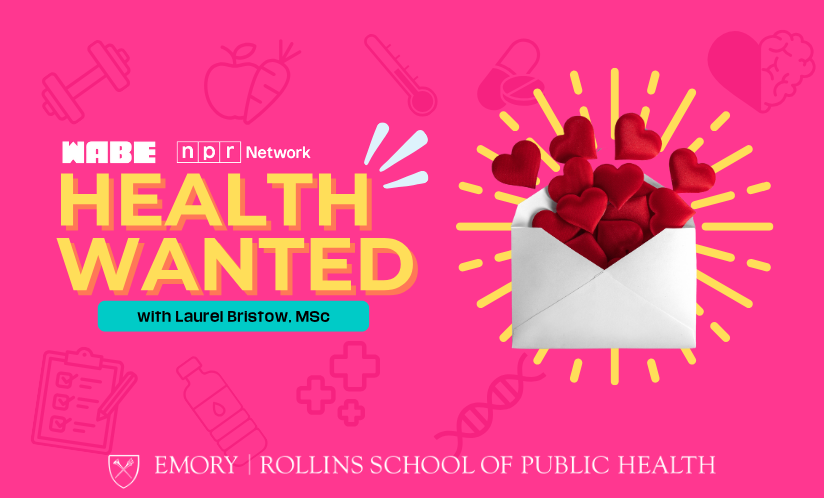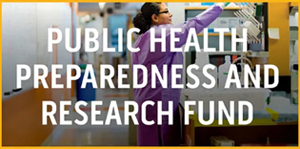Health Wanted: A Valentine for Public Health

HEALTH WANTED, a weekly radio show and podcast produced in partnership with WABE, brings need-to-know public health headlines and breaks down the science behind trending topics.
The Episode
The topic: From past to present, public health has driven essential progress, leaving a positive impact on our health and our hearts. This week on Health Wanted, host Laurel Bristow and guest Lisa Waddell, MD, talk about advancements in public health and the importance of addressing risk factors to improve heart health.
The takeaway: Advancements in public health and safety have driven key changes in regulations and practices that prioritize well-being. These improvements have reduced harm, protected health, and created safer environments.
- Before the Pure Food and Drug Act in 1906, there were no regulations on food safety in the U.S. Some businesses used dangerous approaches to maximize product and profit, like adding formaldehyde to milk, using arsenic as green food coloring, or passing off brick dust as cinnamon. Today, food cannot be altered to hide faults and food labels must be accurate.
- Until pasteurization techniques were adopted in the early 1900s, raw milk often contained bovine tuberculosis. Tuberculosis was the second leading cause of death at the time, and milk was responsible for 15% of those deaths. Milk could also contain listeria, campylobacter, typhoid fever, and E. coli. Today, pasteurization ensures that milk is free of harmful bacteria.
- Ignaz Semmelweis, Hungarian doctor, discovered that maternal mortality from infection was lower in a maternity clinic run by midwives compared to one run by doctors in the 1800s. The doctors did not wash their hands after performing autopsies, while the midwives did not perform autopsies at all. Semmelweis's observations led him to recommend handwashing to reduce infection.
- The foundation of workplace safety began with Alice Hamilton, a doctor in the late 1800s who researched common injuries and health issues faced by workers. Her work contributed to the creation of the Occupational Safety and Health Administration in 1970, which has since reduced workplace deaths by 63% and injuries by 40%.
The Interview
The guest: Lisa Waddell, MD
The key takeaways:
- Cardiovascular problems are serious but mostly preventable. Over 40% of deaths in the U.S. are linked to cardiovascular issues, but many of these problems can be avoided by addressing risk factors like high blood pressure, obesity, smoking, and lack of exercise.
- High blood pressure is a big risk factor for cardiovascular problems. Blood pressure is especially influenced by factors like stress, poor sleep, and excessive sodium intake. High blood pressure is also more prevalent in certain communities, such as Black Americans, who may face higher levels of stress because of social determinants of health.
- The Live to the Beat Campaign aims to reduce heart disease and stroke by offering an online toolkit with educational resources. It features real-life stories from people who have made heart-healthy lifestyle changes, empowering others to follow suit.
- Simple steps like exercising regularly, quitting smoking, managing stress, getting enough sleep, and eating nutritious food can significantly improve heart health and lower the risk of cardiovascular disease. These small, consistent changes can lead to lasting improvements and make a big difference in overall well-being.
The Listener Questions
How can medications for mental health conditions affect sexual arousal?
There are multiple types of medications that can affect sexual arousal. One type is
selective serotonin reuptake inhibitors (SSRIs), a common class of medications used to treat depression and anxiety.
In your brain, serotonin acts as a chemical messenger, passing signals between brain cells. Many of these signals are involved in the regulation of emotions like happiness and contentment. Typically, once the message is passed from one cell to another, the serotonin gets sucked up into the cell. SSRIs block the uptake of serotonin so that there is more available to keep passing these signals of contentment or happiness, which helps combat depression.
This excess serotonin can have a side effect of impacting other hormones or neurotransmitters, like testosterone or dopamine, which can change a person’s ability to become sexually aroused or reach climax.
There are options people can explore if they are experiencing sexual dysfunction as a result of their medication, such as talking to their doctor to see if a lower dose might work or if a different type of medication could help. People can also experiment with timing to see if taking their medication at a certain time of day leads to fewer side effects.
The most important thing to remember is that sex is anything that feels good. It does not have to be penetrative or involve climax. It is important that we remove the stigma of what we think sex should be so that people can have open conversations about what works for them.
I saw a study on Instagram that claims vaccines cause autism. Is this true?
The article is called “Vaccination and Neurodevelopmental Disorders, a Study in Nine-Year-Old Children Enrolled in Medicaid,” and while it looks very official, it is not a paper published in a peer-reviewed journal. It was published on a WordPress blog.
The two biggest, most immediate red flags are that the rest of the content on the website is overtly anti-vaccine and the organization that funded the study is known to be a leading source of misinformation about vaccines.
The paper’s authors have previously had other papers linking vaccines and developmental disorders retracted from actual journals when people began rightly pointing out that the study designs were bad and prone to high levels of bias.
The study used billing codes related to vaccine administration to determine which children received vaccines during their visits. It did not account for children who received vaccines through the Vaccines for Children program, which provides vaccines to kids on Medicaid. The authors could not know if the unvaccinated children are actually unvaccinated or if they just received their vaccines from the free program, which would not be reflected in the billing codes.
The authors also did not try to control for any confounding factors like a family history of neurodevelopmental disorders, which is a huge contributor to risk.
Catch all the listener questions and Laurel’s answers on the full episode of Health Wanted by:
- Streaming at wabe.org or the WABE app
- Subscribing on Apple or Spotify
- Watching on WABE's YouTube channel


